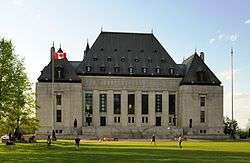Ernest Cormier
| Ernest Cormier | |
|---|---|
 in the 1920's | |
| Born |
December 5, 1885 Montreal, Quebec |
| Died | January 1, 1980 (aged 94) |
| Nationality | Canadian |
| Alma mater | École nationale supérieure des Beaux-Arts |
| Occupation | Architect |
| Buildings | central building of the Université de Montréal; Casault pavilion of Université Laval; Supreme Court of Canada |

Ernest Cormier, OC (December 5, 1885 – January 1, 1980) was a Canadian engineer and architect who spent much of his career in the Montreal area, erecting notable examples of Art Deco architecture, including his home in the Golden Square Mile, Cormier House.
Life and career
He was born in Montreal, the son of a medical doctor, and he studied civil engineering at the École Polytechnique in Montreal. After graduation in 1906, he worked in the research department of the Dominion Bridge Company in Montreal. In 1909, he studied at the École nationale supérieure des Beaux-Arts in Paris in the atelier of Jean-Louis Pascal. In 1914, he was the recipient of the Henry Jarvis Scholarship, awarded by the Royal Institute of British Architects. Through its British Prix de Rome, Cormier spent two years in the Eternal City, where he studied the ancient works. Following his return to Paris in January 1917, he was employed by the engineering firm of Considère, Pelnard et Caquot, specialists in concrete, and he graduated as an architect of the French Government (DPLG).
He was a professor at the École Polytechnique in Montreal (1921–1954).
Major works
Université de Montréal
Cormier's major work is the central building of the Université de Montréal on the north slope of Mount Royal. This huge example of the Art Deco style was built between World War I and the middle of World War II and it has been kept in a nearly pristine shape over the decades. It is a composition of simple forms of planes and surfaces in successive relief, emphasizing vertical lines. The light buff vitrified brick has trimmings of Missisquoi marble.[1] The only major destruction of his designs took place within the interior spaces. These changes occurred in the 1970s when the great multi-storey hall of the central library was filled up with several smaller, single-storey rooms for the faculty of medicine and its library.
Casault pavilion
Another important example of Cormier's work can be found on another Québec university campus, the Casault pavilion of Université Laval, familiarly known by students as the 'Louis-Jacques'. Designed in 1948 but only completed in 1960, it is a massive cathedral-like building, originally designed as Québec City's Grand Séminaire, which is particularly spectacular viewed from a distance along the impressive mall that runs along the East-West axis of the campus grounds.[2] Despite an unfortunate renovation scheme in the 1970s, which gutted the chapel, filled in the magnificent enclosed courtyard and transformed the interior into an undecipherable labyrinth, the building has become the most recognized landmark of the second oldest university in North America and home to Laval's faculties of Music and Communications, as well as to Québec's National Archives.
Rhode Island churches
Cormier also designed two important Roman Catholic Churches for the Diocese of Providence, Rhode Island, USA.[3] One of them, St. John the Baptist Church of Pawtucket, Rhode Island, has been placed on the National Register of Historic Places.
Maison Cormier
Cormier's own home, on Montreal's avenue des Pins, is one of the finest examples of an Art Deco dwelling in the world. Pierre Trudeau purchased the building and lived there following his retirement until his death in 2000.
Supreme Court of Canada Building
Cormier is also responsible for the classic chateau-styled Supreme Court of Canada building (1939–40) in Ottawa.[4]
Other commissions
He was a design consultant for the United Nations building in New York and in Toronto, Cormier designed St. Michael's College School (1950) and Carr Hall at St. Michael's College (University of Toronto, 1954).[5]
Style and legacy
In addition to showing a great balance, in most of his buildings, between the disciplines of engineering and architecture, Cormier also had great skills as a painter and illustrator. He has left us many stunning renderings of his works, done in the planning stages.
In 1974, Cormier was inducted into the Order of Canada by Governor General Jules Léger, and received numerous honours and awards. The Édifice Ernest-Cormier (which he co-designed), the Quebec Court of Appeal building in Old Montreal, is named in his honour.[6]
See also
References
- ↑ "A photograph of the Université de Montréal campus in an aerial view, ca. 1928". Art Deco and the Decorative Arts in the 1920s and 1930s Digital Exhibition. McGill University Library. Retrieved 20 February 2014.
- ↑ Photo
- ↑ http://www.broadstreetexperience.com/historicvalue.htm Notre Dame, Central Falls, Rhode Island, USA
- ↑ Pound, Richard W. (2005). 'Fitzhenry and Whiteside Book of Canadian Facts and Dates'. Fitzhenry and Whiteside.
- ↑ "About - Our History". University of St. Michael's College in the University of Toronto. Retrieved 2012-05-02.
- ↑ Ulysses Travel Guide, Quebec
Further reading
- Isabelle Gournay, editor, Ernest Cormier and the Université de Montréal. Translation by Terrance Hughes and Nancy Côté. Montréal : Canadian Centre for Architecture, 1990.
- Adrian Tinniswood, The Art Deco House: Avant-Garde Houses of the 1920s and 1939s. New York: Watson-Guptil Publications, 2002.
- Ulysses Travel Guides, Collective (2007). Montreal. Montreal: Ulysses Travel Guides. ISBN 978-2-89464-797-4. External link in
|publisher=(help)
External links
| Wikimedia Commons has media related to Ernest Cormier. |
